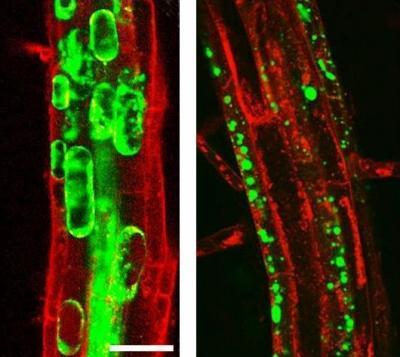A method for increasing plants’ tolerance to salt stress and thus preventing stunted growth and even plant death has been developed. The method has significant consequences for dealing with soil salinization, which is an acute problem for a wide range of crops in many regions of the world. Magnified photo at left shows the invasion of heavy oxidation (green bubbles) in the membrane of a wild, stressed, salt-sensitive plant. At right, following genetic manipulation, the bubbles are broken up and "caged" into tiny vesicles, thus preventing interference with the flow of vital nutrients in the plant. Credit: Illustration courtesy the Hebrew University
Magnified photo at left shows the invasion of heavy oxidation (green bubbles) in the membrane of a wild, stressed, salt-sensitive plant. At right, following genetic manipulation, the bubbles are broken up and "caged" into tiny vesicles, thus preventing interference with the flow of vital nutrients in the plant. Credit: Illustration courtesy the Hebrew University
The problem is largely exasperated by intense agriculture and irrigation. Salinity drives the plant into water deficit and is accompanied by toxicity of sodium and chloride ions, resulting in restricted growth and reduction in yield. Moreover, salt stress causes a secondary oxidative stress, resulting in the more severe cases in plant death.
Through detailed laboratory studies, Prof. Alex Levine and his Ph.D. student Yehoram Leshem, of the Department of Plant and Environmental Sciences at the Alexander Silberman Institute of Life Sciences at the Hebrew University, were able to achieve a new understanding of the specific mechanisms by which plants deal with salt stress conditions.
Based on this knowledge, and through implementation of genetic manipulation techniques, Levine and Leshem were successful in significantly reducing the self-induced membrane damage that takes place under the plants’ stressful conditions. The altered plants were also shown to have greater salt tolerance.
The work by Levine and Leshem – published in a recent article in the Proceedings of the National Academy of Sciences (PNAS) in the U.S. -- not only has opened new insights into a basic understanding of plant responses to salt stress, but also points the way to new applicative pathways for plant breeders to improve salt tolerance in a broad spectrum of agricultural crops. It thus represents a significant step forward that can bring great economic and social benefit to many nations of the world.